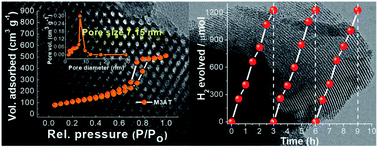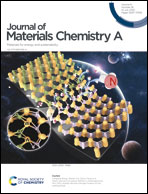Directed holey and ordered g-C3N4.5 nanosheets by a hard template nanocasting approach for sustainable visible-light hydrogen evolution with prominent quantum efficiency†
Abstract
It is desirable yet challenging to synthesize a highly ordered holey carbon nitride material with excess nitrogen atoms for a sustainable solar H2 evolution. Herein, we report the development of directed highly ordered nitrogen-rich honeycomb-like mesoporous carbon nitride nanosheets by using a novel synthetic approach for this purpose. The unique formation route, surface structure and charge carrier dynamics of the two dimensional holey nanosheets are comprehensively monitored and confirmed by SAXS, HRTEM, AFM, BET, XPS and TRPL analyses. Non-stoichiometric high nitrogen content mesoporous nanosheets with the final stoichiometry of g-C3N4.5 acquiring a high specific surface area (382 m2 g−1), remarkable pore size (7.2 nm) and sheet thickness ∼5–6 nm are realized in this first report. This elegant material possesses unique low band-gap energy (2.42 eV). Remarkably, the as-synthesized g-C3N4.5 NSs exhibit a record high photocatalytic H2 evolution rate of 8180 μmol g−1 h−1 under the present light irradiation (420 ≤ λ ≤ 510 nm) condition. The apparent quantum efficiency is found to be as high as 27.14% at 420 nm and retains its photocatalytic activity for longer consecutive catalytic cycles. Bigger pore size and pore volume, and thin walls leading to shortening of the path length of exciton pairs, efficient charge separation and the prolonged average life time of the charge carriers, and lone electron pairs associated with the excess nitrogen content are found to be the reasons behind the excellent visible light driven water splitting reaction.



 Please wait while we load your content...
Please wait while we load your content...